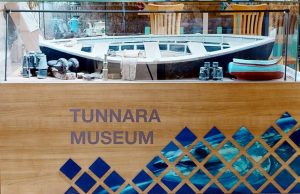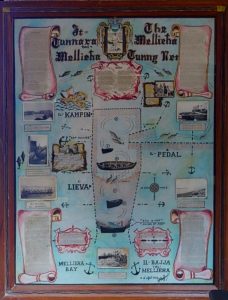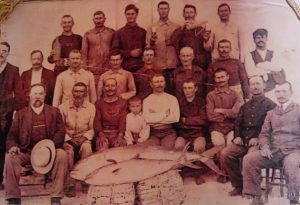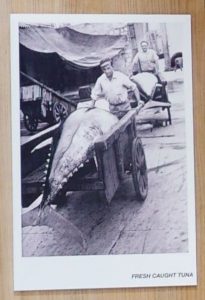It-Tunnara

Tuna fishing was practiced in the Mediterranean since as far back as 8000 BC, as blue fin tuna vertebrae were found in ancient archaeological sites in Greece. The blue fin tuna “thunnus thynnus” can grow up to 3.7 meters in length, weigh as much as 680 kilograms and live for up to 30 years.
In 1748, the first tunnara was introduced by the Grand Master Pinto. The tuna net was elevated and positioned at outside in Mellieha Bay, known for schools of full-blown blue fin tuna, a few kilometres away from the coast.
 In the months of May, June and July, blue fin tuna migrate from the Atlantic ocean to the warmer Mediterranean sea, through the Straits of Gibraltar, arriving at the original spawning grounds and returning back to the Atlantic after the season has completed in September until October.
In the months of May, June and July, blue fin tuna migrate from the Atlantic ocean to the warmer Mediterranean sea, through the Straits of Gibraltar, arriving at the original spawning grounds and returning back to the Atlantic after the season has completed in September until October.
For many Mellieha fishermen, the tuna industry was their only livelihood. The fishermen were known as baħrin, and the head of the fishermen was called ir-rajjes or il-padrun. There was one tunnara, called Tal- Iskol and another one Di Giadina, amongst others.
When the tunnara was fully raised, the villagers would go down to the bay for the blessing of the net. The parish priest was rowed on a boat to the tunnara site and bless the net praying for a productive fishing season for the safety of the men.
villagers would go down to the bay for the blessing of the net. The parish priest was rowed on a boat to the tunnara site and bless the net praying for a productive fishing season for the safety of the men.
In the entrance of the tunnara, the padrun would set a big wooden cross, bearing artistic holy picture of their patron, The Madonna of Mellieħa and other devoted Saints. The men would also hanged palm fronds, blessed on Palm Thursday facing the Mellieħa Sanctuary.
The first tuna net was laid on the 3 April 1748, after two months waiting on boats in the blazing sun, the net was raised with a large number of tuna and other big fish.
 The fishermen became very skilful and the tunnara was so prosperous that other tunnaretti were erected. The tunnara was easily movable, so that the net was set according to the wind and the sea currents – namely iċ-Ċirkewwa, l-irdum id-delli”, il-Ġnejna, l-Għadira, il-Mistra, and San Pawl il-Baħar.
The fishermen became very skilful and the tunnara was so prosperous that other tunnaretti were erected. The tunnara was easily movable, so that the net was set according to the wind and the sea currents – namely iċ-Ċirkewwa, l-irdum id-delli”, il-Ġnejna, l-Għadira, il-Mistra, and San Pawl il-Baħar.
The nets were anchored, secured to the seabed. The largest anchor weighed 4400 kg and was coasted at ix-Xquq, later becoming known as Anchor Bay.
The tunnara, consisted of two massive long meshed nets, made of coconut palm, which extended at right angles from the coast. It had a series of chambers made of vertical nets anchored by stone slabs and kept vertical by about 500 buoys or cork floats, along with about 30 anchors and other stones tied to ropes.
The net was set in position according to tuna migratory habits. The tuna unaware of what lies before them, enter the first room of the tuna trap and passing through the net, entered from one chamber to the another, until finally reaching the chamber of death, from which there was no escape. This chamber had a horizontal floor of netting called the cradle. A large number of fishermen toil at the same time, on three different types of vessels – ix-Xieru, supported by a luzzu and a barkazza.
The main boat was ix-Xieru, – long and coated with black tar, at least sixty feet long and rowed with large oars to the middle of the Mellieħa Bay. The Xieru had a crew of 40 and was strongly built to withstand the stress of sixteen men struggling at one side raising the net full of tuna. Il-Luzzu tas-sinjal, was placed in front of the tunnara, with the necessary night lanterns to localise where the tunny net was set.
coated with black tar, at least sixty feet long and rowed with large oars to the middle of the Mellieħa Bay. The Xieru had a crew of 40 and was strongly built to withstand the stress of sixteen men struggling at one side raising the net full of tuna. Il-Luzzu tas-sinjal, was placed in front of the tunnara, with the necessary night lanterns to localise where the tunny net was set.
The Luzzu is a Maltese traditional type of fishing boat, propelled by sails or oars and later by motor engines. It usually reaches 15 meters in length, with the bow and the stern rising above the rest of the boat in order to protect the crew from the spray of the sea, when moving against the waves. The boat was brightly painted in shades of yellow, red, green and blue. The prow has the most prominent feature, a pair of carved and painted eye of Osiris or Horus.
The Barkazza, was a strong boat which accompanied ix-xieru when trapping the tuna fish. It was built strong to withstand the hard work of the tunnara. It contained a wooden windless midships for the purpose of stretching the heavy tunny net. The boat was placed in a way to guard the entrance of the net chamber. The men received the tuna in the chamber and signalled the arrival of the tuna to the padrun.
From another barkazza, the padrun would give the order to open the doors and let the tuna pass into the chamber of the death. When the net was full, the padrun would shout rise, and with great ability the sailors would start lifting the parbuckle of the big net with the strength of their arms while loudly reciting prayers and singing folk songs, which were passed down over from one generation to the next.
As the bottom of the net was elevated to the surface, the frantic fish would beat the surface of the sea into white spume, as they leap to escape by rapidly vibrating fins and shaking tails. The tuna was left to swim to get weak before they were hooked one by one with long-poled hooks.
 They were carefully handled to avoid bruising and with great difficulty, the large fish was pulled by several men with a hitch and placed in the edge of the boat. When all the tuna was pulled out, the sailors would sink and anchor the empty cradle net into the seabed.
They were carefully handled to avoid bruising and with great difficulty, the large fish was pulled by several men with a hitch and placed in the edge of the boat. When all the tuna was pulled out, the sailors would sink and anchor the empty cradle net into the seabed.
During all this, a red flag would to signal the rise. The church bells start ringing, while the Mellieħa villagers rush down to the bay, to give a hand with the pulling of the heavy long boats, huge tuna nets, or loading the big fish on carts, to be carried to the fish market, in Valletta.
They had the custom to give one tuna to the inquisitor, as a token for their good catch. The fisherman had a special devotion towards Our Lady of Mellieha. They used to give another tuna to the Mellieha Sanctuary, to be raffled.
Between 1827 and 1920 the owners, masters and fishermen gave one third of their catch to the Sanctuary. A way to express their gratitude for the abundant catch and for keeping an eye on them white fishing, they gave candles and oil-lamp to be lit in front of the icon of “Il-Madonna tal-Mellieħa”.
For many years, fishmongers proudly roamed every village calling out – “fresh red eye fish – Mellieħa tuna”.
In 1907, a warehouse was built at Anchor Bay to be used for the tunnara needs. Later they stored the nets and the equipment in the Westreme battery at it-truciera, in Mellieħa Bay,built in 1715 by the Knights of St John.
It is known that in 1930’s, Dun Franġisk Borg, known as tan-Niġes was the manager of the tunnara, succeeded by Arthur Bonnici who was later succeeded by his relative Ġużi Bugeja.
The manager, was the owner of the tunnara equipment and the holder of the fishing permit. He was responsible for the selling of the catch and he was paid a quarter of the profit in tax. After the manager had his share, the rest of the balance was divided equally between the fishermen.
Women helped the men in the repairing and layout of the nets in the Sanctuary square, to let dry before storing them for winter. Children also gave a hand with selling of the tuna and assisted with the storing of the nets, in the small rooms at the Mellieha Sanctuary and at the homes of the padrun and crew.
In 1961, the tunnara, was cast at l-Imgiebaħ, in the north of Malta, hoping for a bigger catch, when a British military vessel based in Malta, not knowing the tunnara fishing position, passed over the nets, causing great damage to the equipment.
Owing to financial difficulties the owner and crew, refrained from rebuilding the tunnara. This hard decision meant the end the of the memorable days of the Mellieħa fishing industry.